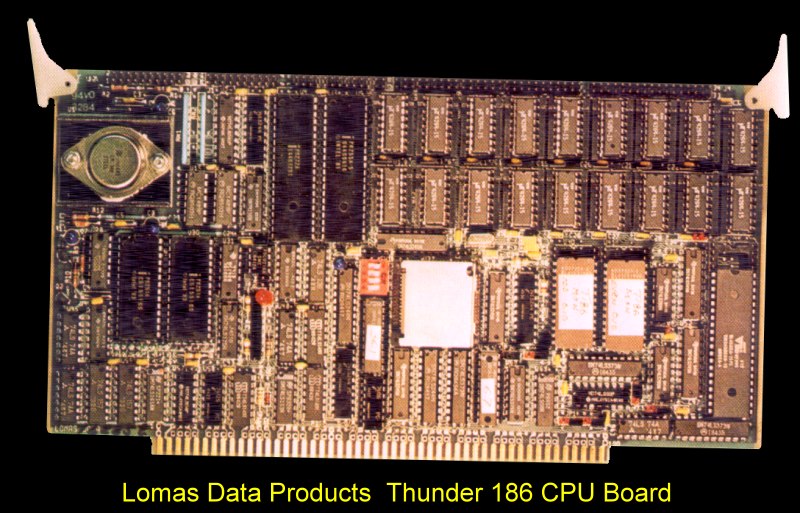This was a very densely packed S-100 board containing an Intel 80186 CPU
amongst many other things. It came out around 1985.
The board featured an 8-MHz 80186, 256K of Dynamic RAM, two serial
ports, and one parallel port. It could control both 8"- and 5" floppy disk
drives. Many of the features of the Thunder-186 were actually
functions of the 80186 chip. The processor of course was object code
compatible with the 8086/8088, allowing it on run most popular software
packages of the time. In addition, the 80186 provided several new
instructions, most notably those for block I/O, pushall and popall
registers, and some immediate arithmetic. The real benefit of the 80186 was
its inclusion on board of several functions normally requiring peripheral
chips. This allowed the designer to package more capabilities on a single
S-100 board. In the Thunder-186, some of the extra capabilities were an
interrupt controller, two DMA controllers, and three timer/counter
functions. One of the DMA controllers was used as a floppy disk controller.
Two of the timers were used by the serial ports to set the baud rates, and
the other was used as the real-time clock by the supplied CCP/M operating
system that came with the board.
A significant advantage of the 80186 over the 8086 was its hardware
computation of the Intel addressing scheme, which increased the speed by
about 20%. Unfortunately, the external inputs to the timer/counter circuit
aware excluded from the board. These were left out probably because, in the
principal operating mode, the timers are not available (they are tied to the
serial ports and the real-time clock).
The support hardware on the board provides several useful features. The two
serial ports were controlled by two 8251A USARTs. One serial port was used
by the system as a terminal. There is also a parallel channel controlled by
a 8255A. The output of this chip was used as a printer port. The input was
used by the monitor at boot time to read the setup switches, and so was not
generally available.
The board supports any combination of two 8"- and/or 5" floppy disk drives.
This gave great deal of flexibility in using existing equipment. Dynamic
memory was used with no wait states for either 128K or 256K bytes on board.
Up to 1M byte of additional memory may be added by changing the DRAM chips.
Sophisticated user could alter the boot EPROMs. These may be enlarged to a
64K if necessary. The Thunder-186 conformed to the IEEE-696 standard with
pins 65 and 66 additionally defined as external DMA requests. Hence, boards
added to the system should not use these pins for their own functions. Added
boards should also provide a full 20-bit address and 16-bit port decodes, or
conflicts could arise in the system. The board came with a
simple "Zapple like" monitor in ROM, including a function to read a floppy
disk boot sector.
There was a hardware review of the board in the S-100 Journal (vol1,#2,1985).
It can be seen
here.
I do not currently have a manual. If you wish to donate one please let
me know.


